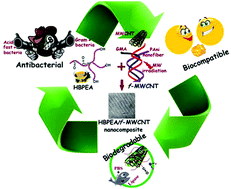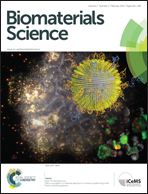Bio-based hyperbranched poly(ester amide)–MWCNT nanocomposites: multimodalities at the biointerface†
Abstract
There has been a growing interest in the use of nanomaterials featuring potent biocompatibility and biodegradability together with the added facet of antibacterial activity, particularly against drug-resistant bacterial species. Addressing these three features at the biointerface, we report the fabrication of multimodal bio-based hyperbranched poly(ester amide) (HBPEA)–microwave functionalized multiwalled carbon nanotube (f-MWCNT) nanocomposites by incorporation of various weight percentages (1, 2.5, and 5 wt%) of the f-MWCNTs into HBPEA by using an ex situ polymerization technique. Fourier transform infrared spectroscopy confirmed the structural changes upon interaction of the f-MWCNTs with HBPEA. The formation of thermosetting nanocomposites resulted in an acceptable improvement of the desired properties including their mechanical properties (∼170%), instrumental for providing mechanical integrity in cultured cells. The nanocomposite films were found to be biocompatible substrates for the in vitro adhesion and proliferation of peripheral blood mononuclear cells (PBMC) with enhanced cell viability correlating with the increase of the f-MWCNT content. The antibacterial results, monitored by a CFU count and the protein concentration, demonstrated that the prepared nanocomposites were more toxic towards Gram positive bacteria and Mycobacterium smegmatis than the Gram negative ones. The damage of bacterial cells upon interaction with the nanocomposites was validated by UV-visible spectroscopy and a SEM study. The antibacterial and biocompatibility studies suggested that these microporous nanocomposite films (3D interconnected porous structures with pore diameters of 5–105 μm and a porosity of 39.90%) possess concurrent long-term lethal activity against the bacterial cells and biocompatibility with PBMC. Thus, the prepared nanocomposites may find potential bio-medical applications, particularly as antimicrobial dressing materials for infected burn wounds.


 Please wait while we load your content...
Please wait while we load your content...